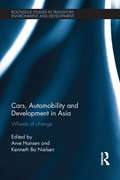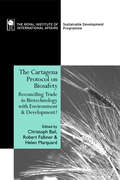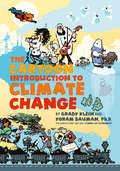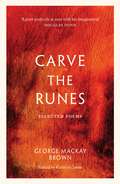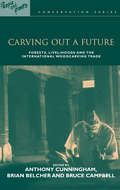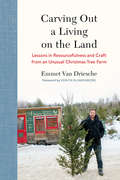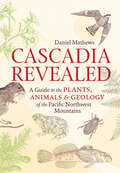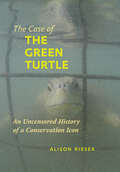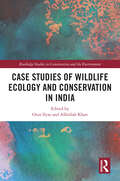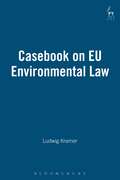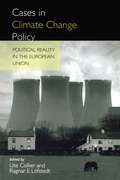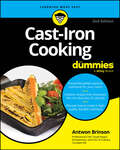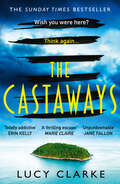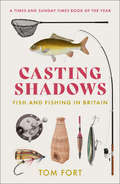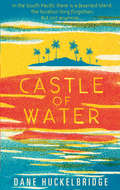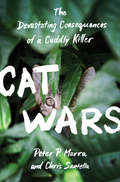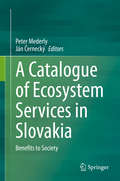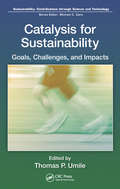- Table View
- List View
Cars, Automobility and Development in Asia: Wheels of change (Routledge Studies in Transport, Environment and Development)
by Arve Hansen and Kenneth Bo NielsenCars, Automobility and Development in Asia explores the nexus between automobility and development in a pan-Asian comparative perspective. The book seeks to integrate the policies, production forms, consumption preferences and symbolism implicated in emerging Asian automobilities. Using empirically rich and grounded analyses of both comparative and single-country case studies, the authors chart new approaches to studying automobility and development in emerging Asia.
Cars, Automobility and Development in Asia: Wheels of change (Routledge Studies in Transport, Environment and Development)
by Arve Hansen Kenneth Bo NielsenCars, Automobility and Development in Asia explores the nexus between automobility and development in a pan-Asian comparative perspective. The book seeks to integrate the policies, production forms, consumption preferences and symbolism implicated in emerging Asian automobilities. Using empirically rich and grounded analyses of both comparative and single-country case studies, the authors chart new approaches to studying automobility and development in emerging Asia.
The Cartagena Protocol on Biosafety: Reconciling Trade in Biotechnology with Environment and Development
by Christoph Bail Robert Falkner Helen MarquardModern biotechnology - the controversial manipulation of genes in living organisms - has far-reaching implications for agriculture, human health, trade and the environment. Against the odds, an international treaty governing biosafety and trade in biotechnology was adopted in 2000. The Cartagena Protocol on Biosafety of the Convention on Biological Diversity deals with one of the most important and challenging issues thrown up by developments in biotechnology. This volume is a comprehensive review of the protocol and the process that led to its adoption. It includes contributions from many of the key players involved and analyses the commercial and political interests at stake, the operations and implications of the protocol, and prospects for the future.
The Cartoon Introduction to Climate Change
by Yoram Bauman Grady KleinClimate change is no laughing matter—but maybe it should be. The topic is so critical that everyone, from students to policy-makers to voters, needs a quick and easy guide to the basics. The Cartoon Introduction to Climate Change entertains as it educates, delivering a unique and enjoyable presentation of mind-blowing facts and critical concepts."Stand-up economist" Yoram Bauman and award-winning illustrator Grady Klein have created the funniest overview of climate science, predictions, and policy that you’ll ever read. You’ll giggle, but you’ll also learn—about everything from Milankovitch cycles to carbon taxes. If those subjects sound daunting, consider that Bauman and Klein have already written two enormously successful cartoon guides to economics, making the notoriously dismal science accessible to countless readers.If economics can be funny, then climate science can be a riot. The Cartoon Introduction to Climate Change takes the intimidation and gloom out of one of the most complex and hotly debated challenges of our time.
Carve the Runes: Selected Poems
by George Mackay BrownIn this, the first new selection of George Mackay Brown’s poetry for over 25 years, Kathleen Jamie explores the multi-faceted world of the poet’s Orkney, his lifelong home and inspiration.George Mackay Brown’s concerns were the ancestral world, the communalities of work, the fables and religious stories which he saw as underpinning mortal lives. Brown believed from the outset that poets had a social role and his true task was to fulfil that role. Art was sprung from the community, and his role as poet to know that community, to sing its stories.
Carving out a Future: "Forests, Livelihoods and the International Woodcarving Trade"
by Brian Belcher Bruce M Campbell Anthony CunninghamVery little has yet been written about the cultural or economic contributions of woodcarving to people's livelihoods or the consequences of felling hardwood and softwood trees for the international woodcarving trade. Carving Out a Future is the first examination of this trade and its critical links to rural livelihoods, biodiversity, conservation, forestry and the international trade regime. A range of case studies from Australia, Bali, India,Africa and Mexico provides a lens for examining the critical issues relating to the significant impacts of woodcarving on forests, conservation efforts, the need to promote sustainable rural livelihoods and efforts to promote trade so that skilled artisans in developing countries get a fair economic return. Livelihoods, Carving and Conservation * Global Overview * The Case of Woodcarving in Kenya * Drums and Hornbills * Sculpture and Identity * Carving Wood in Southern Zimbabwe * The Kiaat Woodcrafters of Bushbuckridge, South Africa * Carvers, Conservation and Certification in India * Colour, Sustainability and Market Sense in Bali * Aboriginal Woodcarvers in Australia * BurseraWoodcarving in Oaxaca, Mexico * Linaloe Wood Handicrafts * Learning from a Comparison of Cases * Carving, Sustainability and Scarcity * Certification of Woodcarving * Planning for Woodcarving in the 21st Century *
Carving out a Future: "Forests, Livelihoods and the International Woodcarving Trade"
by Brian Belcher Bruce M Campbell Anthony CunninghamVery little has yet been written about the cultural or economic contributions of woodcarving to people's livelihoods or the consequences of felling hardwood and softwood trees for the international woodcarving trade. Carving Out a Future is the first examination of this trade and its critical links to rural livelihoods, biodiversity, conservation, forestry and the international trade regime. A range of case studies from Australia, Bali, India,Africa and Mexico provides a lens for examining the critical issues relating to the significant impacts of woodcarving on forests, conservation efforts, the need to promote sustainable rural livelihoods and efforts to promote trade so that skilled artisans in developing countries get a fair economic return. Livelihoods, Carving and Conservation * Global Overview * The Case of Woodcarving in Kenya * Drums and Hornbills * Sculpture and Identity * Carving Wood in Southern Zimbabwe * The Kiaat Woodcrafters of Bushbuckridge, South Africa * Carvers, Conservation and Certification in India * Colour, Sustainability and Market Sense in Bali * Aboriginal Woodcarvers in Australia * BurseraWoodcarving in Oaxaca, Mexico * Linaloe Wood Handicrafts * Learning from a Comparison of Cases * Carving, Sustainability and Scarcity * Certification of Woodcarving * Planning for Woodcarving in the 21st Century *
Carving Out a Living on the Land: Lessons in Resourcefulness and Craft from an Unusual Christmas Tree Farm
by Emmet Van DriescheWhen he first envisioned becoming a farmer, author Emmet Van Driesche never imagined his main crop would be Christmas trees, nor that such a tree farm could be more of a managed forest than the conventional grid of perfectly sheared trees. Carving Out a Living on the Land tells the story of how Van Driesche navigated changing life circumstances, took advantage of unexpected opportunities, and leveraged new and old skills to piece together an economically viable living, while at the same time respecting the land’s complex ecological relationships. From spoon carving to scything, coppicing to wreath-making, Carving Out a Living on the Land proves that you don’t need acres of expensive bottomland to start your land-based venture, but rather the creativity and vision to see what might be done with that rocky section or ditch or patch of trees too small to log. You can lease instead of buy; build flexible, temporary structures rather than sink money into permanent ones; and take over an existing operation rather than start from scratch. What matters are your unique circumstances, talents, and interests, which when combined with what the land is capable of producing, can create a fulfilling and meaningful farming life.
Cascadia Revealed: A Guide to the Plants, Animals, and Geology of the Pacific Northwest Mountains
by Daniel MathewsCascadia Revealred is a must-have guide book for exploring the plants, animals, and fungi of the Pacific Northwest Mountains.
The Case of the Green Turtle: An Uncensored History of a Conservation Icon
by Alison RieserThe journals of early maritime explorers traversing the Atlantic Ocean often describe swarms of sea turtles, once a plentiful source of food. Many populations had been decimated by the 1950s, when Archie Carr and others raised public awareness of their plight. One species, the green turtle, has been the most heavily exploited due to international demand for turtle products, especially green turtle soup. The species has achieved some measure of recovery due to thirty years of conservation efforts, but remains endangered. In The Case of the Green Turtle, Alison Rieser provides an unparalleled look into the way science and conservation interact by focusing on the most controversial aspect of green turtle conservation—farming. While proponents argued that farming green sea turtles would help save them, opponents countered that it encouraged a taste for turtle flesh that would lead to the slaughter of wild stocks. The clash of these viewpoints once riveted the world.Rieser relies on her expertise in ocean ecology, policy, and law to reveal how the efforts to preserve sea turtles changed marine conservation and the way we view our role in the environment. Her study of this early conservation controversy will fascinate anyone who cares about sea turtles or the oceans in which they live.
The Case of the Green Turtle: An Uncensored History of a Conservation Icon
by Alison RieserThe journals of early maritime explorers traversing the Atlantic Ocean often describe swarms of sea turtles, once a plentiful source of food. Many populations had been decimated by the 1950s, when Archie Carr and others raised public awareness of their plight. One species, the green turtle, has been the most heavily exploited due to international demand for turtle products, especially green turtle soup. The species has achieved some measure of recovery due to thirty years of conservation efforts, but remains endangered. In The Case of the Green Turtle, Alison Rieser provides an unparalleled look into the way science and conservation interact by focusing on the most controversial aspect of green turtle conservation—farming. While proponents argued that farming green sea turtles would help save them, opponents countered that it encouraged a taste for turtle flesh that would lead to the slaughter of wild stocks. The clash of these viewpoints once riveted the world.Rieser relies on her expertise in ocean ecology, policy, and law to reveal how the efforts to preserve sea turtles changed marine conservation and the way we view our role in the environment. Her study of this early conservation controversy will fascinate anyone who cares about sea turtles or the oceans in which they live.
Case Studies of Wildlife Ecology and Conservation in India (Routledge Studies in Conservation and the Environment)
by Orus Ilyas Afifullah KhanThis volume brings together a collection of case studies examining wildlife ecology and conservation across India. The book explores and examines a wide range of fauna across different terrains and habitats in India, revealing key issues and concerns for biodiversity conservation, with a particular emphasis on the impact of humans and climate change. Cases are as wide ranging as tigers, leopards, sloth bears, pheasants, insects and birds, across a diverse range of landscapes, including forests, wetlands, nature reserves and even a university campus. Split into three parts, Part I focuses on how the distribution of animals is influenced by the availability of resources such as food, water, and space. Chapters examine key determinants, such as diet and prey and habitat preferences, with habitat loss also being an important factor. In Part II, chapters examine human-wildlife interactions, dealing with issues such as the impact of urbanization, the establishment of nature reserves and competition for resources. The book concludes with an examination of landscape ecology and conservation, with chapters in Part III focusing on habitat degradation, changes in land-use patterns and ecosystem management. Overall, the volume not only reflects the great breadth and depth of biodiversity in India, but offers important insights to the challenges facing biodiversity conservation not only in this region, but worldwide. This volume will be of great interest to students and scholars of wildlife ecology, conservation biology, biodiversity conservation and the environmental sciences more broadly.
Case Studies of Wildlife Ecology and Conservation in India (Routledge Studies in Conservation and the Environment)
by Orus Ilyas and Afifullah KhanThis volume brings together a collection of case studies examining wildlife ecology and conservation across India. The book explores and examines a wide range of fauna across different terrains and habitats in India, revealing key issues and concerns for biodiversity conservation, with a particular emphasis on the impact of humans and climate change. Cases are as wide ranging as tigers, leopards, sloth bears, pheasants, insects and birds, across a diverse range of landscapes, including forests, wetlands, nature reserves and even a university campus. Split into three parts, Part I focuses on how the distribution of animals is influenced by the availability of resources such as food, water, and space. Chapters examine key determinants, such as diet and prey and habitat preferences, with habitat loss also being an important factor. In Part II, chapters examine human-wildlife interactions, dealing with issues such as the impact of urbanization, the establishment of nature reserves and competition for resources. The book concludes with an examination of landscape ecology and conservation, with chapters in Part III focusing on habitat degradation, changes in land-use patterns and ecosystem management. Overall, the volume not only reflects the great breadth and depth of biodiversity in India, but offers important insights to the challenges facing biodiversity conservation not only in this region, but worldwide. This volume will be of great interest to students and scholars of wildlife ecology, conservation biology, biodiversity conservation and the environmental sciences more broadly.
Casebook on EU Environmental Law
by Ludwig KramerThis book comments on fifty key judgments which the Court of Justice and the Court of First Instance have given on European Community environmental law. For each judgment,the facts and procedures are described, followed by an extract of the essential parts of the judgment and a commentary which places the judgment in its legal, environmental and political context and develops the lines of reasoning of the Court. The fifty cases selected cover all substantive and procedural aspects of Community environmental law, as regards the provisions of the EC Treaty (cases 1 to 9), horizontal problems (cases 10 to 18), water and air (cases 19 to 25), products and noise (cases 26 to 32), nature protection (cases 33 to 38), waste management (cases 39 to 45) and procedural questions (cases 46 to 50). Particular emphasis is laid on commenting on recent judgments: thus, the oldest case discussed dates from 1991 and 43 of the 50 judgments date from 1996 or later.The book provides a clear insight into the jurisdiction of the European Courts; it will be of particular use to practitioners of national and Community environmental law, researchers, law students and administrators. It is written in a comprehensible style which also makes it a useful tool for non-lawyers who deal with European Community environmental law and policy.
Cases in Climate Change Policy: Political Reality in the European Union
by Ragnar E. LofstedThis volume examines case studies on EU countries' policy to combat climate change, examining the constraints of and opportunities for the implementation of climate change strategies in these countries. The introductory section provides an overview of the climate change problem and its potential effects, examining the roles of different greenhouse gases, the main emission sources, the likely consequences of climate change and the scope for abatement and adapation. The second part consists of six detailed case studies on diverse national strategies. The book concludes with a comparative analysis of the findings of the case studies, and suggestions for approaches to implement emission reduction strategies.
Cases in Climate Change Policy: Political Reality in the European Union
by Ragnar E. LofstedThis volume examines case studies on EU countries' policy to combat climate change, examining the constraints of and opportunities for the implementation of climate change strategies in these countries. The introductory section provides an overview of the climate change problem and its potential effects, examining the roles of different greenhouse gases, the main emission sources, the likely consequences of climate change and the scope for abatement and adapation. The second part consists of six detailed case studies on diverse national strategies. The book concludes with a comparative analysis of the findings of the case studies, and suggestions for approaches to implement emission reduction strategies.
Cast-Iron Cooking For Dummies
by Antwon BrinsonBecome a cast-iron chef, thanks to this friendly Dummies guide Cast-Iron Cooking For Dummies will teach you everything you need to know to start using the classic cookware that chefs have loved for thousands of years. You’ll learn how to pick the right cast iron tools for your needs, maintain your cookware, and cook foods to perfection. This book is also packed with healthy, diverse, and delicious recipes for meat, fish, stir-fry, and beyond. Cast-iron cookware is versatile, hardy, economical, and great at retaining heat. Well-seasoned cast iron can reduce the need for cooking oil and even makes food taste better. This easy-to-use guide comes complete with color photos and a guide to the best brands. Select the right cast-iron cookware for your daily needs Learn to properly season and maintain your cast-iron Master cooking techniques using versatile, professional cookware Find great recipes that will taste even better when you cook them with cast-ironThis book is an excellent choice for home cooks, beginners, semi-pro cooks, professional cooks, campers, and outdoor cooks—basically anyone looking to cook with cast-iron!
Cast-Iron Cooking For Dummies
by Antwon BrinsonBecome a cast-iron chef, thanks to this friendly Dummies guide Cast-Iron Cooking For Dummies will teach you everything you need to know to start using the classic cookware that chefs have loved for thousands of years. You’ll learn how to pick the right cast iron tools for your needs, maintain your cookware, and cook foods to perfection. This book is also packed with healthy, diverse, and delicious recipes for meat, fish, stir-fry, and beyond. Cast-iron cookware is versatile, hardy, economical, and great at retaining heat. Well-seasoned cast iron can reduce the need for cooking oil and even makes food taste better. This easy-to-use guide comes complete with color photos and a guide to the best brands. Select the right cast-iron cookware for your daily needs Learn to properly season and maintain your cast-iron Master cooking techniques using versatile, professional cookware Find great recipes that will taste even better when you cook them with cast-ironThis book is an excellent choice for home cooks, beginners, semi-pro cooks, professional cooks, campers, and outdoor cooks—basically anyone looking to cook with cast-iron!
The Castaways
by Lucy ClarkeA SECRET BEACH. A HOLIDAY OF A LIFETIME. WISH YOU WERE HERE? THINK AGAIN…
Casting Shadows: Fish And Fishing In Britain
by Tom FortPeer into the secret, silent world of the freshwater fish and explore evolution of the art and industry of fishing in Britain's rivers and streams.
Cat Wars: The Devastating Consequences of a Cuddly Killer
by Peter P. Marra Chris SantellaIn 1894, a lighthouse keeper named David Lyall arrived on Stephens Island off New Zealand with a cat named Tibbles. In just over a year, the Stephens Island Wren, a rare bird endemic to the island, was rendered extinct. Mounting scientific evidence confirms what many conservationists have suspected for some time—that in the United States alone, free-ranging cats are killing birds and other animals by the billions. Equally alarming are the little-known but potentially devastating public health consequences of rabies and parasitic Toxoplasma passing from cats to humans at rising rates. Cat Wars tells the story of the threats free-ranging cats pose to biodiversity and public health throughout the world, and sheds new light on the controversies surrounding the management of the explosion of these cat populations.This compelling book traces the historical and cultural ties between humans and cats from early domestication to the current boom in pet ownership, along the way accessibly explaining the science of extinction, population modeling, and feline diseases. It charts the developments that have led to our present impasse—from Stan Temple's breakthrough studies on cat predation in Wisconsin to cat-eradication programs underway in Australia today. It describes how a small but vocal minority of cat advocates has campaigned successfully for no action in much the same way that special interest groups have stymied attempts to curtail smoking and climate change.Cat Wars paints a revealing picture of a complex global problem—and proposes solutions that foresee a time when wildlife and humans are no longer vulnerable to the impacts of free-ranging cats.
Cat Wars: The Devastating Consequences of a Cuddly Killer (PDF)
by Peter P. Marra Chris SantellaIn 1894, a lighthouse keeper named David Lyall arrived on Stephens Island off New Zealand with a cat named Tibbles. In just over a year, the Stephens Island Wren, a rare bird endemic to the island, was rendered extinct. Mounting scientific evidence confirms what many conservationists have suspected for some time—that in the United States alone, free-ranging cats are killing birds and other animals by the billions. Equally alarming are the little-known but potentially devastating public health consequences of rabies and parasitic Toxoplasma passing from cats to humans at rising rates. Cat Wars tells the story of the threats free-ranging cats pose to biodiversity and public health throughout the world, and sheds new light on the controversies surrounding the management of the explosion of these cat populations.This compelling book traces the historical and cultural ties between humans and cats from early domestication to the current boom in pet ownership, along the way accessibly explaining the science of extinction, population modeling, and feline diseases. It charts the developments that have led to our present impasse—from Stan Temple's breakthrough studies on cat predation in Wisconsin to cat-eradication programs underway in Australia today. It describes how a small but vocal minority of cat advocates has campaigned successfully for no action in much the same way that special interest groups have stymied attempts to curtail smoking and climate change.Cat Wars paints a revealing picture of a complex global problem—and proposes solutions that foresee a time when wildlife and humans are no longer vulnerable to the impacts of free-ranging cats.
A Catalogue of Ecosystem Services in Slovakia: Benefits to Society
by Peter Mederly Ján ČerneckýThis book provides the first comprehensive assessment of ecosystem services (ES) for the territory of the Slovak Republic. Although the ES approach is widely used for the evaluation of the benefits of natural capital and biodiversity for people, this book has a unique character. It provides an assessment of 18 individual ES, which are divided into three main groups - provisioning, regulatory/supporting and cultural ES. For each of ES, a brief theoretical and methodological overview is given, followed by spatial assessment based on own original methodology and dataset of 40 map layers. Besides, an evaluation of main ES groups and overall ES assessment is realized. This book emphasizes the key role of nature protection areas, large areas of forest ecosystems and mountain and sub-mountain areas, for the preservation of the various functions of the healthy landscape and ecosystems. The complexity of the book guarantees its usefulness - not only as the knowledge base for the territory of Slovakia but also as the methodological tool for worldwide researchers.
Catalysis for Sustainability: Goals, Challenges, and Impacts (ISSN)
by Thomas P. UmileCatalysis for Sustainability: Goals, Challenges, and Impacts explores the intersection between catalytic science and sustainable technologies as a means to addressing current economic, social, and environmental problems. These problems include harnessing alternative energy sources, pollution prevention and remediation, and the manufacturing of comm
